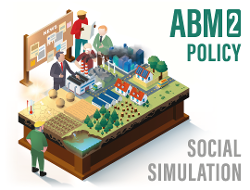
Unanticipated migration inflows can have positive and negative economic and social consequences depending on policies implemented by the recipient country to cope with the manifold challenges. Model-based scientific assessments of in-migration on a country's national economy are hence needed, as is meaningful stakeholder deliberation of alternative policies to support the integration of refugees in ways that contribute to resilient and sustainable societies.
Objectives
The ABM2Policy project is a multidisciplinary endeavor aimed at enhancing the methodology of agent-based modeling (ABM) in the context of the Russian and Austrian economies. The primary objective is to provide a realistic analysis of migration as an external economic shock. In Austria, the project also explores the potential of combining ABM with a gamified user interface to facilitate discussions on migration policymaking.
The project brings together a diverse team of investigators, including economists, modelers, mathematicians, demographers, political scientists, physicists, game developers, and linguists. Their collective efforts have resulted in methodological and applied innovations that transcend traditional discipline-specific approaches.
 © IIASA
© IIASA
IIASA Research
The ABM2Policy project involves a comprehensive analysis of the economic implications of various migration scenarios in Austria. This analysis takes into account the interactions of millions of agents, including households, government entities, banks, and firms operating across multiple markets. The project team developed a unique search and matching mechanism within the ABM to align the labor supply of households with the labor demand of firms. The focus of the study was on climate-induced migration from the MENA region, triggered by extreme drought and locust infestations. The project team collaborated with the European Commission Joint Research Centre to develop specific scenarios.
The project also introduced a model-based policy simulation, known as the Gamified Policy Exercise (GPE). The GPE demonstrated the potential of the ABM to inform policy discussions in the complex context of migration. The exercise centered on three contentious policy issues, namely, assistance to MENA governments, Austria's stance on the new classification of 'environmental refugees', and support for Mediterranean rescue efforts. The GPE was informed by a review of Austria's political party platforms and stakeholder narratives, and was grounded in literature that analyzes political conflict in terms of distinct discourses or plural rationalities.
The GPE involved participants playing the role of parliamentarians with the aim of reaching a consensus on the policy issues at hand. The debate was facilitated by the ABM scenario results, a motivating video, and fact sheets. The exercise was attended by 43 participants from IIASA, the University of Vienna, and the University of Continuing Education, Krems, with 23 post-simulation questionnaires submitted.
The ABM2Policy project contributes to the growing body of literature on large-scale ABMs. It is one of the first studies to calibrate ABMs to the historical trends of key economic variables and to pilot the use of large ABMs in an experimental gamified stakeholder process. The findings of this study are expected to be of interest to a broad international audience, including those in the fields of computational economics, agent-based modeling, simulation games, stakeholder deliberation, and migration policy.
The ABM2Policy project exceeded its initial objectives, demonstrating the versatility and potential of the ABMs. The ABM was not only capable of analyzing the economic implications of migration across different economic sectors and cohorts, but it also challenged the prevailing notion that ABMs are unsuitable for economic forecasting. After calibration and validation, the model proved to be a strong competitor against vector-autoregressive (VAR) and Dynamic Stochastic General Equilibrium (DSGE) models in out-of-sample forecasting of macroeconomic variables.
In a pioneering move, the project showcased an online ABM-based Gamified Policy Exercise, advancing the concept of experiential learning. This exercise involved the participation of researchers and students specializing in migration and geography.
Project deliverables
- D1.1. Agent-based model of the Austrian national economy tailored to represent the economic impacts of migration, and representing key economic agents (firms, human agents, and government), their key interactions, and dynamics
- D1.2. Peer-reviewed journal article discussing the calibration and validation of the Austrian agent-based model
- D1.3. Peer-reviewed journal article discussing a large-scale ABM that can inform migration policy
- D2.1. A website with a detailed description of the gamified interface including all steps (a protocol) and materials to run policy evaluation combined with the agent-based model
- D2.2. Facilitating stakeholder deliberation on climate migration with a gamified ABM-based policy simulation
- D2.3. A guide to the methodology and potential applications of economic agent-based models (ABMs)
Other project publications
Makarov, V., Bakhtizin, A., Beklaryan, G., Akopov, A., Rovenskaya, E. , & Strelkovskii, N. (2019). Aggregated Agent-Based Simulation Model of Migration Flows of the European Union Countries. Ekonomika i matematicheskie metody 55 (1) 3-15. 10.31857/S042473880004044-7.
Makarov, V., Bakhtizin, A., Beklaryan, G., Akopov, A., Rovenskaya, E. , & Strelkovskii, N. (2020). Agent-based modelling of population dynamics of two interacting social communities: migrants and natives (Агентное моделирование популяционной динамики двух взаимодействующих
сообществ: мигрантов и коренных жителей) [in Russian]. Ekonomika i matematicheskie metody 56 (2) 5-19. 10.31857/S042473880009217-7.
Makarov, V., Bakhtizin, A., Beklaryan, G., Akopov, A., Rovenskaya, E. , & Strelkovskii, N. (2022). Agent-based modeling of social and economic impacts of migration under the government regulated employment [in Russian]. Economics and the Mathematical Methods 58 (1) 113-130. 10.31857/S042473880018960-5.
Makarov, V., Bakhtizin, A., Beklaryan, G., Akopov, A., & Strelkovskii, N. (2022). Simulation of migration and demographic processes using FLAME GPU. Business Informatics 16 (1) 7-21. 10.17323/2587-814X.2022.1.7.21.
Pajak, M., Magnuszewski, P., Poledna, S., Strelkovskii, N. , Rovenskaya, E. , Goujon, A. , Conte, A., Linnerooth-Bayer, J., Fresolone-Caparrós, A. , Catalano, M., & Campo, P. (2023). A model-based policy exercise to examine climate migration policy in Europe. In: Klimatag 2023, 11-13 April 2023.
News

28 September 2022






